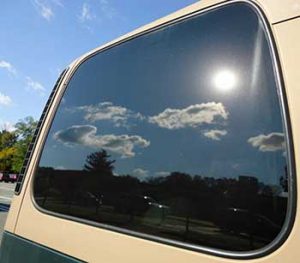In today’s article, we will talk about tinted windows. Now it has started to become more and more fashionable to have tinted windows on the car.
The car tinted film has become very used lately due to the aesthetic benefits that it brings, being able to greatly change the appearance of a car. Applying the film, whether it’s on the rear window, or even on all windows, has many advantages.
Contents
Advantages of tinted car windows.

Considered by some as just a whim, the car foil has many real benefits, far exceeding the aesthetic side. UV protection, but also thermal protection are among its main advantages.
- A great advantage would be that the tinted film applied to the windows will give you a much greater intimacy. In the case of a longer drive, passengers can sleep peacefully without showing up. Or you can leave goods in the car without being afraid that they will attract thieves because they will not be able to look inside.
- Another reason why you should apply tinted film to the car windows is that it acts as a pair of sunglasses, significantly reducing the influence of ultraviolet rays on passengers. They will not be disturbed or affected in any way by the sun, they will be able to enjoy the journey.
- Also, tinted windows will reduce fuel consumption during the summer. Why? Well, the tinted film offers very good protection against sunlight (doesn’t let the heat get in the car). Once the heat does not get into the car so easily, you will no longer have to start the air conditioning to the maximum because it does not cope with cooling the cabin.
- At the same time, the tinted film also protects the upholstery, the front board and the elements of wood, plastic or leather contributing to the extension of their life span. Exposing to the sun, the leather dries, hardens and cracks, the plastic tends to soften, fade, crack and become brittle, and the wood color fades over time.
- The exterior design can be changed very much after applying a tinted film on the windows, it will radically change its appearance. Regardless of whether the car you drive is elegant or sport, the film will highlight the style/aggressiveness of the car.
How long does a tinted film last on a window?
Somehow tinting your windows removes the car from anonymity, which changes both the exterior and interior appearance. As a long-term investment, a tinted film is a very good investment because it can last up to five years.
The weather conditions do not affect the foil, although it is a decorative one, it is intended to withstand all kinds of weather conditions. Also, the windows will be protected from scratches, heat, cold, and inside will always be a pleasant environment.
For those who can afford, there is also an anti-theft tinted film, but even the simple one is a good option because it will prevent thieves from looking in the car.
Anti-theft films offer much greater resistance to the window on which it is mounted. You can find on the Internet a lot of demonstration videos that show the resistance of the anti-theft films. Also in the event of an accident, the windows will not break into pieces, the film will keep the pieces gathered.
How long does it take to tint your car windows?
Applying the tinted film on the window lasts somewhere up to 2 hours and the price varies depending on the quality of the film and the size of the car.
Is it legal or not to have tinted windows on a car?
According to some laws in Europe and in the USA, the windshield must have minimum transparency of 75% in the visual field of the driver. The side windows on the front must have minimum transparency of 70%. And for the other windows, transparency can be less than 70%. But laws regarding this subject may vary from country to country
For those who want to apply this type of film to the windows of their car, you must know that whether it is tinted or transparent (protective) it had to be properly certified and, in some cases, marked, and the application must be done in an authorized workshop. The rear window is not considered to be a window with an important role for the driver’s visibility, provided that the car is equipped with exterior rear-view mirrors on both sides.
Usually, most drivers choose to have tinted film mounted only on the side-rear windows and rear window of the car. Some countries, however, allow the installation of such films on the front windows as well.
And on the windshield, you can mount an anti-UV film (you may have seen cars that have a purple windscreen, well they have applied this type of film on it) for protection, especially because it happens that at high speeds a little stone can jump from the road and can crack the windshield or protect it from scratches produced by wipers.
On the windscreen, it is best to apply only a protective film (100% transparency), especially if you want to be legal 🙂 this is also known as a light-adaptive film.

What exactly is a light-adaptive film?
Well, normally, this light-adaptive film closes (tints) when the sun rays hit it and open ( becomes transparent) when it is not exposed in the sun.
This feature protects the eyes of the driver from the blinding light of the sun but allows maximum visibility in poorer light conditions. So it is a very good investment especially for those who drive a lot. Some more expensive cars come with this factory equipment also knows as an infrared solar glass.
But at the same time, we must know that for those who do not obey the law and are caught in traffic with a non-approved film they can remain without the car’s registration papers until the problem is solved or even without the car 🙂 and a fine, and it’s not small. There are also devices that can measure the transparency of the windows.
How much does it cost to tint car windows?
The tinted films and protective films can cost from $ 200 up to $ 3000 depending on the type of film. There are a lot of advantages that tinted film offers and surely, it is worth every penny.
Here are some rules may or may not apply to the tinted film on the windows
- Regardless of the mounting technology (with or without disassembly), the plastic film is applied only on the inside of the windows, relative to the vehicle;
- Never apply the plastic film, regardless of the light transmittance value on the windscreen of vehicles;
- For windows other than the windscreen, which are in the driver’s field of vision, the normal light transmittance for the assembly of the initial glass and the applied film must not be less than 70%. It turns out that a film with a light transmittance of at least 70% can be applied to the windows mentioned above only if they are clear (colorless).
- For the windows in the driver’s field of vision, the normal light transmittance for the assembly made of the initial glass and the applied foil must not be less than 70%. However, if the vehicle is equipped with two exterior rear-view mirrors (left and right), these windows are considered to be no longer part of the backward field of vision and therefore the light transmittance for the whole assembly may be less than 70%.
- If the vehicle is equipped with the additional stop lamp (S3, S4) installed inside the car cabin and whose light is diffused through the rear window glass, then the applied film must not obstruct the light area of the lamp.
- After installation, the films should not have any crease, ruptures or scratches that affect the visibility or distort the image optically. On each window, the certification mark for the type of film applied and a specific label to the economic agent that will identify it (name, authorization number) and specify the final transmission of the glass will be applied.
- The assembly of the films on the windows provided with defrosting systems is allowed only if they are included in the glass mass. It is not allowed to mount the films on the windows provided with defrosting systems applied to the glass.
